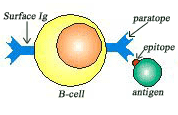
 |
 |
|
| Home | submission | Help | Output format | Algorithm | Team |
| SCALE | X | A | R | N | D | C | Q | E | G | H | I | L | K | M | F | P | S | T | W | Y | V |
| Hydrophilicity | 0.00 | 2.10 | 4.20 | 7.00 | 10.00 | 1.40 | 6.00 | 7.80 | 5.70 | 2.10 | -8.00 | -9.20 | 5.70 | -4.20 | -9.20 | 2.10 | 6.50 | 5.20 | -10.0 | -1.9 | -3.7 |
| Flexibility | 0.00 | -1.27 | 2.79 | 1.77 | 1.42 | -1.09 | 1.18 | 1.60 | 1.86 | -0.82 | -2.89 | -2.29 | 2.88 | -1.84 | -2.14 | 0.52 | 3.00 | 1.18 | -3.78 | -3.3 | -1.75 |
| Accessibility | 0.00 | 0.49 | 0.95 | 0.81 | 0.78 | 0.26 | 0.84 | 0.84 | 0.48 | 0.66 | 0.34 | 0.40 | 0.97 | 0.48 | 0.42 | 0.75 | 0.65 | 0.70 | 0.51 | 0.76 | 0.36 |
| Exposed | 0.00 | 15.00 | 67.00 | 49.00 | 50.00 | 5.00 | 56.00 | 55.00 | 10.00 | 34.00 | 13.00 | 16.00 | 85.00 | 20.00 | 10.00 | 45.00 | 32.00 | 32.00 | 17.00 | 41.00 | 14.00 |
| Turns | 0.00 | -0.8 | -1.15 | 3.00 | 1.65 | 0.83 | 0.11 | -0.92 | -0.55 | 2.56 | -1.53 | -1.01 | -1.06 | -1.48 | 0.18 | 0.64 | 1.34 | 0.27 | -0.97 | -0.29 | -0.83 |
| Antegenic | 0.00 | 1.064 | 0.873 | 0.776 | 0.866 | 1.412 | 1.015 | 0.851 | 0.874 | 1.105 | 1.152 | 1.250 | 0.930 | 0.826 | 1.091 | 1.064 | 1.012 | 0.909 | 0.893 | 1.161 | 1.383 |
| Polarity | 5.00 | 0.00 | 52 | 3.38 | 40.7 | 1.48 | 3.53 | 49.91 | 0.00 | 51.6 | 0.15 | 0.45 | 49.50 | 1.43 | 0.35 | 1.58 | 1.67 | 1.66 | 2.1 | 1.61 | 0.13 |
Parker Method: In this method, hydrophilic scale based on peptide retention times during high-performance liquid chromatography (HPLC) on a reversed-phase column was constructed (Parker et al., 1986). A window of seven residues was used for analyzing epitope region. The corresponding value of the scale was introduced for each of the seven residues and the arithmetical mean of the seven residue value was assigned to the fourth, ( i+3), residue in the segment.
Karplus Method: In this method, flexibility scale based on mobility of protein segments on the basis of the known temperature B factors of the a-carbons of 31 proteins of known structure was constructed (Karplus and Schulz, 1985). The calculation based on a flexibility scale is similar to classical calculation, except that the center is the first amino acid of the six amino acids window length, and there are three scales for describing flexibility instead of a single one. In the present study, 3Karplus scale was used for the prediction of the epitope region.
Emini Method: The calculation was based on surface accessibility scale on a product instead of an addition within the window. The accessibility profile was obtained using the formulae Sn = ( n+4+i) (0.37) -6 Where Sn is the surface probability, dn is the fractional surface probability value, and i vary from 1 to 6. A hexapeptide sequence, with Sn equal to unity and probabilities greater than 1.0 indicates an increased probability for being found on the surface (Emini et al., 1985).
Pellequer Method: This method is based on incidence of b turns (Pellequer et al., 1993). The calculation was based on a turn scale and there were three scales for describing turns instead of a single one. A window of seven residues is used for analyzing epitope region. The corresponding value of the scale was introduced for each of the seven residues and the arithmetical mean of the seven residue value is assigned to the fourth, (i+3), residue in the segment. Gaussian smoothing curve was used, which assigns the residue weights in a window of seven residues (the weights were 0.05/0.11/0.19/0.22/0.19/0.11/0.05).
Kolaskar Method: In this method 156 antigenic determinants (< 20 amino acids) in 34 different proteins were analyzed (Kolaskar and Tongaonkar, 1990) to calculate the antigenic propensity (Ap ) of residues. This antigenic scale was used to predict the epitopes in sequence.
Exposed surface scale and Polarity scale: The physico-chemical properties like exposed surface (Janin and Wodak, 1978) and polarity (Ponnuswamy et al., 1980) has also been evaluated in this study. A window of seven residues has been used for analyzing the epitope region. The corresponding value of the scale has been introduced for each of the seven residues and the arithmetical mean of the seven residue value is assigned to the fourth, (i+3), residue in the segment.
Both threshold dependent and independent measures have been used to evaluate the prediction performance.